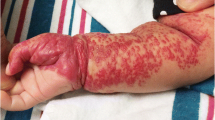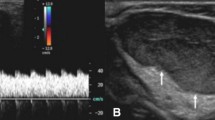Abstract
Soft-tissue vascular anomalies such as haemangioma and vascular malformation are treated by surgical resection, arterial embolization or sclerotherapy. Because the effect of sclerotherapy, i.e. the percutaneous injection of sclerosing agents, depends on intralesional haemodynamics, estimation of flow characteristics of soft-tissue vascular anomalies is essential when determining appropriate patient management. However, lesions are at present divided into only two groups: high flow and low flow. We have developed a new method, direct puncture scintigraphy, to evaluate in detail the haemodynamics of vascular anomalies under conditions simulating sclerotherapy. Twenty-six soft-tissue vascular anomalies in 21 patients were studied. After 30 MBq of technetium-99m Sn colloid was injected percutaneously into the intravascular space of the lesion, dynamic imaging was performed for 5 min. A time-activity curve for the lesion was generated, with the infiltrated activity on injection subtracted. A monoexponential curve was fitted to the declining phase of the time-activity curve, and mean vascular transit time (MTT) was obtained. The lesions were classified into high-flow and low-flow lesions based on radionuclide angiography with intravenous injection of99mTc-labelled red blood cells, and estimates of MTT in the two groups were compared. The imaging procedures were carried out with no major complications, and broad intralesional diffusion of99mTc-Sn colloid was achieved in most lesions. The high-flow lesions (six lesions) had a short MTT, ranging from 1.6 to 3.4 s, while the low-flow lesions (20 lesions) had a longer MTT, with no overlap between the groups. MTT showed a wide range in low-flow lesions: it was less than 30 s in six lesions and more than 10 min in five other lesions. Direct puncture scintigraphy provides a quantitative indicator of the flow characteristics of soft-tissue vascular anomalies, and may aid in determining treatment strategies for patients with vascular anomalies.
Similar content being viewed by others
References
Mulliken JB, Glowacki J. Hemangiomas and vascular malformations in infants and children: a classification based on endothelial characteristics.Plast Reconstr Surg 1982; 69: 412–420.
Finn MC, Glowacki J, Mulliken JB. Congenital vascular lesions: clinical application of a new classification.J Pediatr Surg 1983; 18: 894–899.
Enjorlas O, Mulliken JB. The current management of vascular birthmarks.Pediatr Dermatol 1993; 10: 311–333.
Jackson IT, Carreno R, Potparic Z, Hussain K. Hemangiomas, vascular malformations, and lymphovenous malformations: classification and methods of treatment.Plast Reconstr Surg 1993; 91: 1216–1230.
Kahan L, Mulliken JB. Vascular anomalies of the maxillofacial region.J Oral Maxillofac Surg 1986; 44: 203–213.
Mulliken JB. A biologic approach to cutaneous vascular anomalies.Pediatr Dermatol 1992; 9: 356–357.
Vaksman G, Rey C, Marache P, et al. Severe congestive heart failure in newborns due to giant cutaneous hemangioma.Am J Cardiol 1987; 60: 392–394.
Kasabach HH, Merrit KK. Capillary hemangioma with extensive purpura.Am J Dis Child 1940; 59: 1063–1070.
Govrin-Yehudain J, Moscona AR, Calderon N, Hirshowitz B. Treatment of hemangiomas by sclerosing agents: an experimental and clinical study.Ann Plast Surg 1987; 18: 465–469.
Svendsen P, Wikholm G, Fogdestam I, Naredi S, Eden E. Instillation of alcohol into venous malformations of the head and neck.Scand J Plast Reconstr Hand Surg 1994; 28: 279–284.
Stricht JVD. The sclerosing therapy in congenital vascular defects.Int Angiol 1990; 9: 224–227.
Baker LL, Dillon WP, Hieshima GB, Dowd CF, Frieden IJ. Hemangiomas and vascular malformations of the head and neck: MR characterization.AJNR 1993; 14: 307–314.
Huston J III, Forbes GS, Ruefenacht DA, Jack CR, Clay RP. Magnetic resonance imaging of facial vascular anomalies.Mayo Clin Proc 1992; 67: 739–747.
Burrows PE, Mulliken JB, Fellows KE, Strand RD. Childhood hemangiomas and vascular malformations: angiographic differentiation.AJR 1983; 141: 483–488.
Hardoff R, Gips S, Front A. Imaging patterns of vascular lesions of the head and neck demonstrated by Tc-99m labeled red blood cells.Clin Nucl Med 1992; 17: 288–291.
Yoshida H, Yusa H, Ueno E. Use of Doppler color flow imaging for differential diagnosis of vascular malformations: a preliminary report.J Oral Maxillofac Surg 1995; 53: 369–374.
Martin PJ, Gaunt ME, Naylor AR, Hope DT, Orpe V, Evans DH. Intracranial aneurysms and arteriovenous malformations: transcranial colour-coded sonography as a diagnostic aid.Ultrasound Med Biol 1994; 20: 689–698.
Hurwitz DJ, Kerber CW. Hemodynamic considerations in the treatment of arteriovenous malformation of the face and scalp.Plast Reconstr Surg 1981; 67: 421–432.
Author information
Authors and Affiliations
Rights and permissions
About this article
Cite this article
Inoue, Y., Ohtake, T., Wakita, S. et al. Flow characteristics of soft-tissue vascular anomalies evaluated by direct puncture scintigraphy. Eur J Nucl Med 24, 505–510 (1997). https://doi.org/10.1007/BF01267681
Received:
Revised:
Issue Date:
DOI: https://doi.org/10.1007/BF01267681




